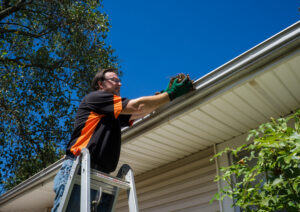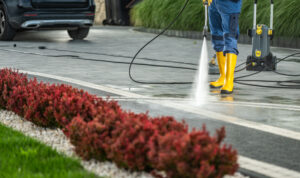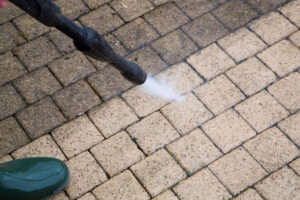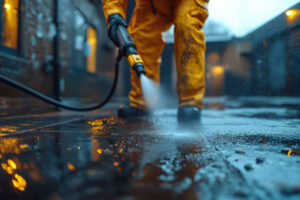My driveway looked like a crime scene last March. White streaks everywhere, chunks of concrete flaking off like dandruff, and these weird crystalline formations growing from cracks I swear weren’t there in November. My neighbor Pete walked by and said, “First winter with a new driveway, huh? You gotta power wash it!”
Turns out, that pretty white coating wasn’t just ugly—it was eating my concrete alive.
What Rock Salt Actually Does
I thought salt just melted ice. Simple chemistry, right? Wrong. That innocent-looking rock salt is basically concrete cancer. Every winter, we dump pounds of it on our driveways, it does its job, and then we forget about it until spring reveals the carnage.
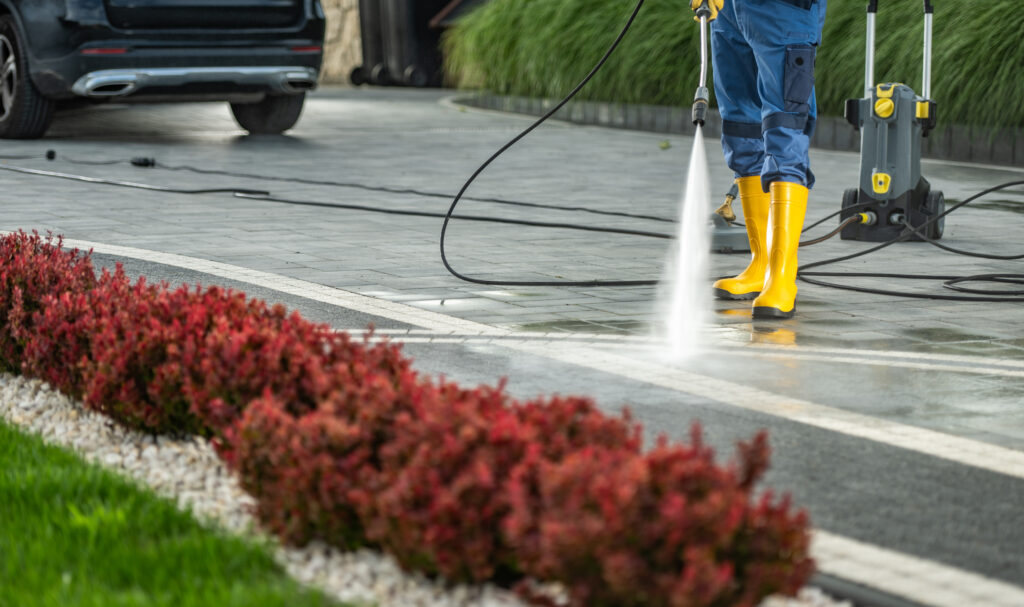
Power Washing Residential Driveway
Here’s what Mike, the contractor who eventually fixed my disaster, explained: “Salt doesn’t just sit there. It seeps into concrete, attracts moisture, freezes, expands, and basically explodes your driveway from the inside out.” He showed me a chunk of concrete that crumbled in his hand like a stale cookie. “This was somebody’s front walk. Two winters of salt, no spring cleaning.”
Jersey winters are particularly brutal because of the freeze-thaw cycle. It hits 45 degrees Tuesday, drops to 20 Wednesday, back up to 40 Thursday. Each cycle, that salt water in your concrete expands and contracts. It’s like doing thousands of tiny push-ups on your driveway’s internal structure.
The Damage You Can See (And What You Can’t)
Those white streaks? That’s the salt you can see. The real damage happens underneath. I learned this the expensive way when what looked like minor surface flaking turned into chunks of driveway coming up with the spring weeds.
My friend Jennifer thought her driveway was just “getting character” after five winters. Then last April, she backed out of her garage and left a basketball-sized piece of driveway behind. “It just… came up with my tire,” she said, holding a hunk of concrete like a confused archeologist.
The salt damage shows up in stages:
- First, you get the white film
- Then comes surface scaling (fancy term for flaking)
- Next, those hairline cracks become actual cracks
- Finally, chunks start breaking off like Jennifer’s basketball
But here’s the kicker—by the time you see serious damage, the salt’s been working inside for months or years.
Why Spring Cleaning Isn’t Optional
“Can’t I just let the rain wash it away?” I asked Mike. He actually laughed. “Rain makes it worse. Drives the salt deeper.”
April and May are critical in Jersey. The ground’s thawing, we’re getting those heavy spring rains, and all that salt residue is still active. It’s like leaving battery acid on your car—time doesn’t make it better.
My next-door neighbor learned this lesson hard. Five years of “letting nature handle it” turned his driveway into what his wife calls “the lunar surface.” Craters, cracks, and entire sections where you can see the gravel base. His replacement estimate? $8,000.
Meanwhile, Pete across the street has the same age driveway, looks nearly new. His secret? “First warm day in March, I’m out there with the hose and some cleaner. Every year, no exceptions.”
The Right Way to Clean (And the Wrong Way I Tried)
My first attempt at spring cleaning involved a regular hose and determination. Two hours later, I’d basically moved the salt around, creating new white patterns like some kind of toxic zen garden.
Here’s what actually works, according to Mike and confirmed by three years of doing it right:
Wait for a day above 50 degrees. Cold water on cold concrete doesn’t do much except create ice if the temperature drops.
Start with a good rinse, but not a gentle one. You need pressure. Not necessarily pressure-washer pressure (though that helps), but definitely more than a gentle spray.
Use a concrete cleaner designed for salt removal. Yes, they make specific products for this. No, dish soap doesn’t count. I tried. It just made bubbles that dried into salty bubbles.
The crucial part: rinse, rinse, rinse. Then rinse again. Salt loves to hide in pores and cracks. What looks clean will dry white again if you don’t thoroughly flush it out.
Timing Is Everything
In Jersey, that sweet spot is usually mid-March to early April. You want the last salt application to be at least a few weeks old, but you don’t want to wait so long that spring rains have driven it deep into the concrete.
I mark my calendar for the first 60-degree Saturday in March. Sometimes that’s March 10, sometimes it’s March 25. But when it hits, I’m ready. Learned that from watching Pete, who seems to have a sixth sense for optimal driveway cleaning weather.
“Too early and you might get another snow,” he told me. “Too late and the damage is setting in. It’s like changing your oil—there’s a window.”
Prevention Beats Repair Every Time
After dropping two grand on driveway repair, I got religious about prevention. Spring cleaning is just part one. Mike gave me the full defensive strategy:
Seal your driveway every other year. “It’s like sunscreen for concrete,” he said. Creates a barrier between salt and concrete. Costs about $200 to DIY, saves thousands in repairs.
Use less salt in winter. I know, easier said than done when you’re staring at an ice rink. But alternatives exist. Sand for traction, calcium chloride (less damaging than rock salt), or those pet-safe melters that won’t eat concrete.
Fix cracks immediately. Every crack is a highway for salt water. I keep a tube of concrete crack filler in my garage now. See a crack in fall? Fill it before winter arrives.
The Professional Route
Some years, I admit defeat and call in professionals. After the brutal winter of 2021 (remember that February?), my driveway looked like a salt flat in Utah. The pros showed up with equipment that looked like it belonged at a car wash.
Steam cleaning, they called it. Hot water, commercial-grade cleaners, and enough pressure to strip paint. My driveway looked ten years younger in an hour. Cost $300, but considering the alternative was eventual replacement, it felt like a bargain.
The guy running the steamer told me something interesting: “We see the same driveways every spring. The people who call us regularly? Minor touch-ups. The ones who wait five years? Major restoration.”
What Happens If You Don’t
My cousin in Tom’s River ignored his driveway for seven years. “It’s concrete,” he said. “It’s literally rock. How bad could it get?”
Last spring, he called me. “Remember how you warned me about salt damage? Yeah, about that…” His driveway looked like it had been through a war. Entire sections had crumbled, rebar showed through in places, and the repair estimate was more than his property tax bill.
The contractor who looked at it was blunt: “This isn’t repair, it’s replacement. Should’ve been washing this every spring.”
The Bottom Line
Living in Jersey means dealing with winter salt. It’s not optional unless you enjoy ice skating to your car. But letting that salt sit on your driveway all spring and summer? That’s choosing to write a big check later instead of doing basic maintenance now.
Every March, I see my neighbors out with hoses and brushes, and we all nod at each other knowingly. We’re the spring cleaning club, saving our driveways one rinse at a time. It’s not fun, it’s not exciting, but neither is explaining to your spouse why the driveway needs replacing after only ten years.
Pete was right when he spotted my salt-damaged driveway that first spring. “First winter with a new driveway, huh?” But thanks to him and Mike and some expensive lessons, it won’t be my last.
This March, when that first warm Saturday hits, you’ll find me outside with the hose. Because in Jersey, spring cleaning isn’t just about making things look nice—it’s about making them last through another year of whatever winter throws at us.

